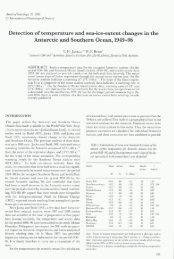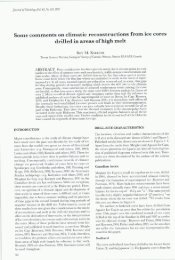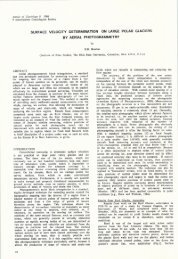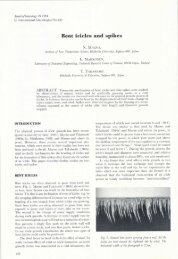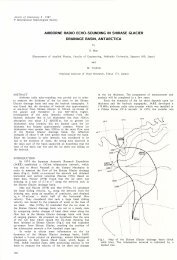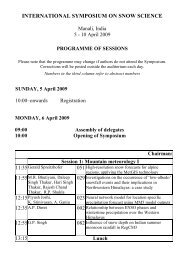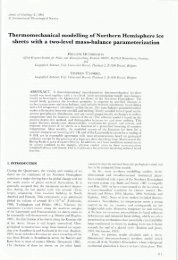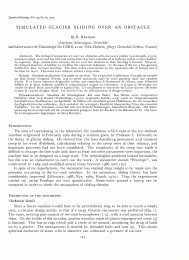Instruments and Methods Geophysical imaging of alpine rock glaciers
Instruments and Methods Geophysical imaging of alpine rock glaciers
Instruments and Methods Geophysical imaging of alpine rock glaciers
Create successful ePaper yourself
Turn your PDF publications into a flip-book with our unique Google optimized e-Paper software.
Maurer <strong>and</strong> Hauck: <strong>Instruments</strong> <strong>and</strong> methods 117<br />
Fig. 9. As for Figure 8, but with our interpretations superimposed on<br />
the tomograms. The borehole logs are also displayed. DC1 <strong>and</strong> S1<br />
represent the active layer, DC3 is the ice-rich core <strong>of</strong> the <strong>rock</strong><br />
glacier, S2 represents degraded permafrost <strong>and</strong> S3 is the bed<strong>rock</strong><br />
interface. R1 represents an ice-rich zone, R2 is a layer with large<br />
voids, R3 is either ice-rich or includes voids (see text) <strong>and</strong> R4 is the<br />
water-saturated part <strong>of</strong> the <strong>rock</strong> glacier.<br />
intervals <strong>and</strong> the 53 sources were separated from each other<br />
by �5.6 m. The total pr<strong>of</strong>ile length was 297.5 m (Fig. 7).<br />
The resultant tomographic seismic image in Figure 8b is<br />
characterized by pronounced variations <strong>of</strong> seismic speed.<br />
A 5–10 m thick surface layer <strong>of</strong> low-speed material extends<br />
the length <strong>of</strong> the line (S1 in Fig. 9b). Between 160 <strong>and</strong> 200 m<br />
horizontal distance, low speeds can be traced to even<br />
greater depths (low-speed body S2 in Fig. 9b). Towards both<br />
ends <strong>of</strong> the pr<strong>of</strong>ile, speeds immediately below the nearsurface<br />
low-speed layer are >4000 m s –1 . Speeds are uniformly<br />
>4000 m s –1 along the base <strong>of</strong> the entire image<br />
(interface S3 in Fig. 9b delineates approximately the upper<br />
boundary <strong>of</strong> speeds >4000 m s –1 ).<br />
4.4. Cross-hole radar survey<br />
Using low-frequency (22 MHz) transmitter <strong>and</strong> receiver<br />
antennas (�3 m long), cross-hole radar data were collected<br />
between boreholes B4 <strong>and</strong> B1 <strong>and</strong> between B4 <strong>and</strong> B2.<br />
Transmitter <strong>and</strong> receiver spacings were both 1 m. Tomographic<br />
inversions <strong>of</strong> the travel-time data were performed<br />
using an algorithm described by Maurer <strong>and</strong> Green (1997).<br />
Further details <strong>of</strong> the experiment can be found in Musil <strong>and</strong><br />
others (2006).<br />
Perspective images <strong>of</strong> the tomographic planes B4–B1 <strong>and</strong><br />
B4–B2 are shown in Figures 8c <strong>and</strong> 9c. They are<br />
characterized by a background speed <strong>of</strong> �120 m ms –1 <strong>and</strong><br />
Fig. 10. Integrated interpretation <strong>of</strong> geoelectric (blue lines) <strong>and</strong><br />
seismic (red lines) images from the Muragl <strong>rock</strong> glacier. The borehole<br />
logs <strong>of</strong> B1 <strong>and</strong> B2 are also displayed. DC1 <strong>and</strong> S1 represent the<br />
active layer, DC3 is the ice-rich core <strong>of</strong> the <strong>rock</strong> glacier, S2<br />
represents degraded permafrost <strong>and</strong> S3 is the bed<strong>rock</strong> interface.<br />
imbedded zones <strong>of</strong> both higher <strong>and</strong> lower speed. At depths<br />
<strong>of</strong>




